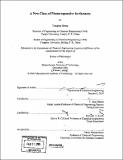| dc.contributor.advisor | T. Alan Hatton and Kenneth A. Smith. | en_US |
| dc.contributor.author | Shang, Tiangang, 1969- | en_US |
| dc.contributor.other | Massachusetts Institute of Technology. Dept. of Chemical Engineering. | en_US |
| dc.date.accessioned | 2007-02-20T15:29:30Z | |
| dc.date.available | 2007-02-20T15:29:30Z | |
| dc.date.copyright | 2004 | en_US |
| dc.date.issued | 2005 | en_US |
| dc.identifier.uri | http://dspace.mit.edu/handle/1721.1/28845 | en_US |
| dc.identifier.uri | http://hdl.handle.net/1721.1/28845 | |
| dc.description | Thesis (Ph. D.)--Massachusetts Institute of Technology, Dept. of Chemical Engineering, February 2005. | en_US |
| dc.description | Includes bibliographical references. | en_US |
| dc.description.abstract | In this thesis, a new class of nonionic, photoresponsive surfactants consisting of a polar di(ethylene oxide) head group attached to an alkyl spacer of between two and eight methylene groups, coupled through an ether linkage to an azobenzene moiety, were synthesized and developed. Structural changes associated with the interconversion of the azobenzene group between its cis and trans forms as mediated by the wavelength of an irradiating light source, cause changes in the surface tension, critical micellization concentrations (CMC), and self-assembly behavior. Differences in saturated surface tensions (at concentrations above their CMCs) were as high as 14.4 mN/m under radiation of different wavelengths. This large and reversible change in saturated surface tensions in response of different illumination conditions made these new surfactants have potential applications in the pumping and control of flow in microfluidic devices, and in the microchemical analysis of complex fluids, flow cytometry, rapid DNA screening. The interfacial properties of these new surfactants have been investigated through surface tension measurements and neutron reflection experiments under both UV and visible light. From surface tension measurements, the surface excess and therefore average molecular areas can be obtained through Gibbs equation; while through measuring neutron reflectivities at different Q range, the interfacial conformations of these surfactants can be determined within the resolution of several angstroms. It was found that the interfacial conformations of these surfactants are very sensitive to the length of the spacer and conformation of azobenzene group. Depending on the different lengths of spacer and conformations of azobenzene groups (trans or cis), | en_US |
| dc.description.abstract | (cont.) surfactants can take either regular conformation or loop conformation, in which the spacer between the polar head and the intermediate polar group forms a loop anchored at both ends in the interfacial plane. This explained the observed large change in saturated surface tensions under different wavelengths radiation. The self-assembly behavior of these surfactants in bulk phase has been studied experimentally through the static and dynamic light scattering, small angle neutron scattering, and cryo-TEM techniques under both UV and visible light. At high enough concentrations, trans surfactants form the vesicles; while cis surfactants self-assemble into bicontinuous phase. This transition indicated the significance of the sign of Gaussian rigidity in surfactant self-assembly. Through varying the azobenzene conformation by radiation of different wavelengths, the sign of the Gaussian rigidity can be controlled, and therefore, there self-assembly behavior can be controlled by light too. | en_US |
| dc.description.statementofresponsibility | by Tiangang Shang. | en_US |
| dc.format.extent | 188 leaves | en_US |
| dc.language.iso | eng | en_US |
| dc.publisher | Massachusetts Institute of Technology | en_US |
| dc.rights | M.I.T. theses are protected by copyright. They may be viewed from this source for any purpose, but reproduction or distribution in any format is prohibited without written permission. See provided URL for inquiries about permission. | en_US |
| dc.rights.uri | http://dspace.mit.edu/handle/1721.1/28845 | en_US |
| dc.rights.uri | http://dspace.mit.edu/handle/1721.1/7582 | |
| dc.subject | Chemical Engineering. | en_US |
| dc.title | A new class of photoresponsive surfactants | en_US |
| dc.type | Thesis | en_US |
| dc.description.degree | Ph.D. | en_US |
| dc.contributor.department | Massachusetts Institute of Technology. Department of Chemical Engineering | |
| dc.identifier.oclc | 60388010 | en_US |
